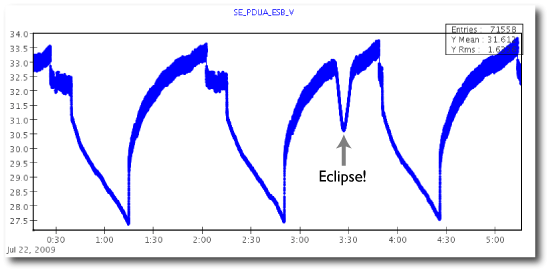
My UCSC Astronomy Dept. colleague Enrico Ramirez-Ruiz sent me a cool graph the other day. It amounts to a photometric transit observation of an R~1700 Km satellite of a habitable terrestrial planet.

Enrico writes:
The attached figure shows the main power voltage to LAT (Large Area Telescope instrument on the Fermi Satellite). There is a regular pattern of increasing voltage when the battery is being charged, a plateau when charging is complete but we are still in sunlight, and discharge when Fermi moves out of sun. You can see a sudden dip in voltage at 3:30 UT when the sun is blocked.
Last week’s total solar eclipse prompted me to think back to the last millennium, to July 11, 1991, when the previous eclipse of Saros series 136 occurred. My fellow graduate students and I drove down to the center line near the tip of the Baja Peninsula. I wrote down my recollections, which we later adapted for one of the chapter vignettes in The Five Ages.
The partial eclipse phases lasted for more than an hour. Even as an ever-larger fraction of the Sun was obscured, the change was so gradual that eyes adjusted continuously. The slackening of the daylight went unnoticed until about fifteen minutes before totality, as more than 90 percent of the Sun’s face was obscured. Due to the reduced sunshine over a swatch of the Earth as large as the diameter of the Moon, the morning was unusually cool for a Mexican July. By 10:00 A.M., the temperature was only in the seventies. The thermometer dropped slightly as the eclipse progressed, and when the daylight finally began to visibly dim, the air seemed almost chilly. The surface of the ocean looked dull and flat, but without the slate gray color of a cloudy day. Cumulus clouds billowed over the distant spine of mountains like an accelerated film.
All at once, the dunes were awash in subtle shadowy ripples, like caustics at the bottom of a midday swimming pool. The ripples drifted slowly across the sand, their contrast flickering. The bands persisted for less than a minute, and then seemed to evaporate. The wind seemed to grow stronger.
With only a minute left, the sky grew darker every second. The air was alive with flapping fruit bats that had been fooled into emerging by the unnatural dusk. A dangerous stray glance at the sun gave a moment’s impression of a starlike point. With five seconds left, the black shadow of totality swept toward us across the water at nearly two thousand miles an hour.
The starlike impression of the Sun was superseded by the disk of the Moon easing into place. A final, fleeting, brilliant burst of light flashed out as the Sun shone through a valley on the limb of the Moon. Totality descended, the stars leapt out, and the nebulous electric blue corona arced away from the black disk.
